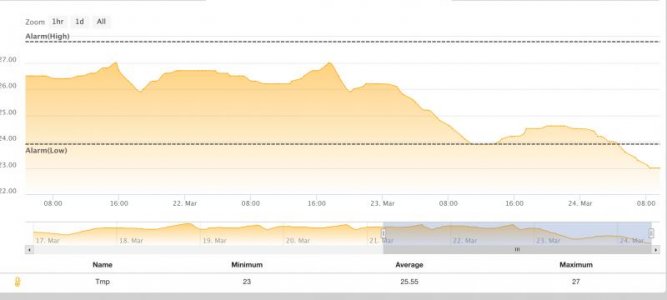First would like to say a big thanks to the online resource. The hobby would be nowhere near as enjoyable without this advice on hand (and probably a lot more expensive).
I live in Perth Western Australia where external temps reach a low of around 41F in the middle of winter. I am wanting to keep my tank temp at 78.8F.
Reading through all the forums I was convinced I needed an APEX Controller which I purchased just recently. Awesome piece of equipment once I ironed out the wifi connection issues and salinity probe calibration problems. Prior to this I was none the wiser about constant measurements.
Overnight, the temps fell to around 51F, so not very cold but when I woke this morning I had several temp alarms on the tank. You can see from my Apex temps dropped fairly suddenly (see attachment). I have two very cheap 300W glass heaters in my external sump which clearly were unable to do much to avoid this rapid drop in temps, which is only going to be much more marked once winter hits.
My setup is as follows:
1. 260G tank in my living area (double glazing, temp controlled room so very comfortable and not the cause of temp drop)
2. Tank plumbed to an external 160G sump sitting at the back of the house enclosed by a metal hutch with no insulation at all (i.e. ambient external temperature)
3. Two x 200G plastic (not insulated) external reservoir tanks connect to the system that serve to increase circulating water capacity of the system and plumbed to the street verge so that with water changes I simply dump 260G from these tanks and this is filled from the street with fresh sea water (water quality in Perth is fantastic so I don't make my own).
So from this you will see that I loose most of my water temps from the external reservoir tanks and sump.
Now I could do plenty by insulating external tanks but wanted to see first if I could simply heat overnight because during the days temps in winter generally reach around 65F.
I was wanting advice on what people think watt size required for heating. I was thinking about getting 2 x 600 w SCHEGO TITANIUM HEATERS placed in the sump.
Any thoughts would be great.
I live in Perth Western Australia where external temps reach a low of around 41F in the middle of winter. I am wanting to keep my tank temp at 78.8F.
Reading through all the forums I was convinced I needed an APEX Controller which I purchased just recently. Awesome piece of equipment once I ironed out the wifi connection issues and salinity probe calibration problems. Prior to this I was none the wiser about constant measurements.
Overnight, the temps fell to around 51F, so not very cold but when I woke this morning I had several temp alarms on the tank. You can see from my Apex temps dropped fairly suddenly (see attachment). I have two very cheap 300W glass heaters in my external sump which clearly were unable to do much to avoid this rapid drop in temps, which is only going to be much more marked once winter hits.
My setup is as follows:
1. 260G tank in my living area (double glazing, temp controlled room so very comfortable and not the cause of temp drop)
2. Tank plumbed to an external 160G sump sitting at the back of the house enclosed by a metal hutch with no insulation at all (i.e. ambient external temperature)
3. Two x 200G plastic (not insulated) external reservoir tanks connect to the system that serve to increase circulating water capacity of the system and plumbed to the street verge so that with water changes I simply dump 260G from these tanks and this is filled from the street with fresh sea water (water quality in Perth is fantastic so I don't make my own).
So from this you will see that I loose most of my water temps from the external reservoir tanks and sump.
Now I could do plenty by insulating external tanks but wanted to see first if I could simply heat overnight because during the days temps in winter generally reach around 65F.
I was wanting advice on what people think watt size required for heating. I was thinking about getting 2 x 600 w SCHEGO TITANIUM HEATERS placed in the sump.
Any thoughts would be great.

